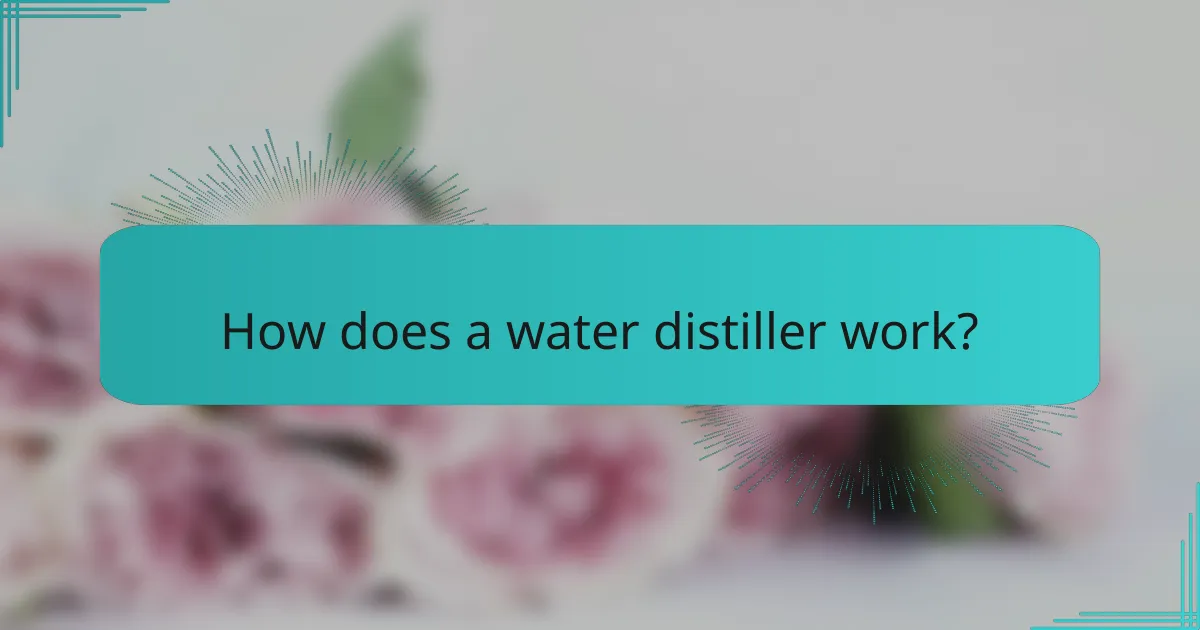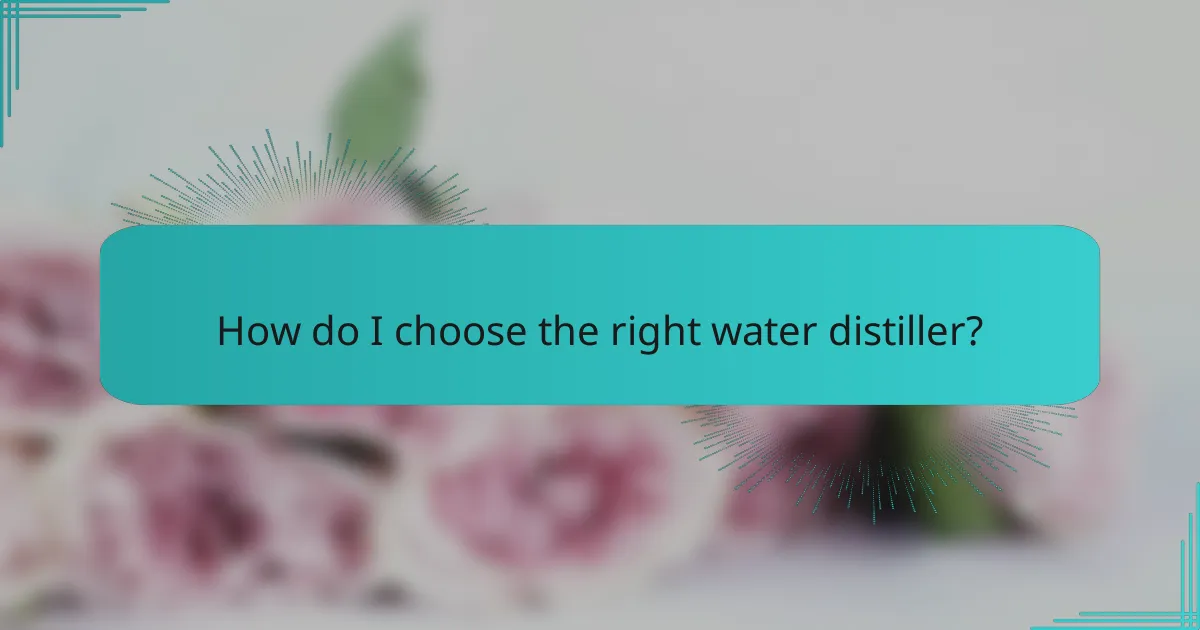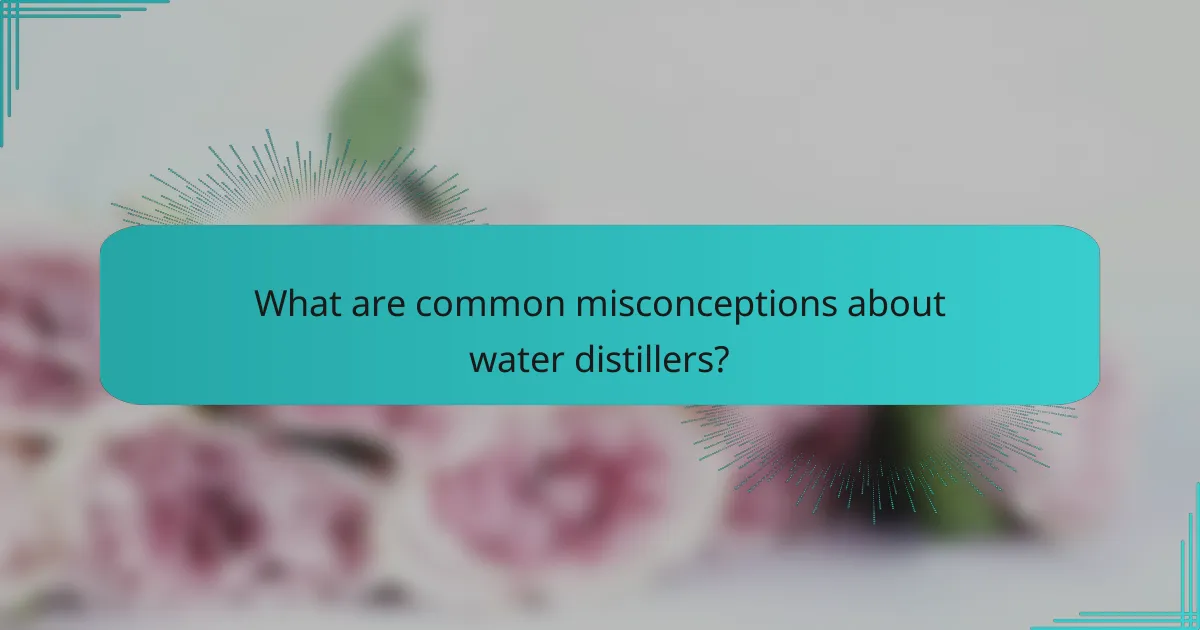A water distiller is an efficient solution for producing high purity water by effectively removing impurities through a simple heating and condensation process. This method not only ensures clean drinking water but also offers ease of use, making it an ideal choice for households. With options like the Megahome Water Distiller and the Pure Water Mini-Classic, users can enjoy reliable and high-quality water at home.

What are the benefits of using a water distiller in the UK?
Using a water distiller in the UK offers several advantages, including the effective removal of impurities, the production of high purity water, and simple operation for users. These benefits make distillers a popular choice for ensuring clean drinking water at home.
Removes impurities effectively
A water distiller works by boiling water and then condensing the steam back into liquid, effectively separating impurities such as minerals, chemicals, and contaminants. This process can remove a wide range of pollutants, including chlorine, lead, and bacteria, ensuring that the water you consume is free from harmful substances.
In the UK, where tap water quality can vary, using a distiller can provide peace of mind. Regular maintenance and cleaning of the distiller are essential to ensure optimal performance and to prevent any buildup of contaminants in the unit itself.
Produces high purity water
Water distillers are known for producing water with a high purity level, often exceeding 99% purity. This is particularly beneficial for those who are sensitive to certain minerals or chemicals found in regular tap water.
High purity water is ideal for various applications, including cooking, making beverages, and even for use in aquariums or humidifiers. Users can expect consistent quality, making it a reliable choice for households prioritizing health and wellness.
Simple operation for users
Operating a water distiller is straightforward, typically involving just a few steps: fill the tank with water, turn on the machine, and wait for the distillation process to complete. Most models come with user-friendly controls and indicators to simplify the experience.
For best results, it’s advisable to follow the manufacturer’s instructions regarding water levels and maintenance schedules. Regularly checking for any mineral buildup and cleaning the unit will help maintain its efficiency and longevity.

How does a water distiller work?
A water distiller operates by heating water to create steam, which then condenses back into liquid form, effectively removing impurities. This process results in high purity levels, making it a reliable method for obtaining clean drinking water.
Heating water to create steam
The first step in the distillation process involves heating water in a boiling chamber until it reaches its boiling point, typically around 100 degrees Celsius. As the water heats up, it transforms into steam, which carries away dissolved solids, minerals, and other contaminants.
It’s important to ensure that the heating element is efficient and capable of reaching the necessary temperature quickly. Many modern distillers can complete this phase in under an hour, depending on the water volume.
Condensing steam back to liquid
Once the steam is generated, it travels through a cooling system where it condenses back into liquid water. This occurs in a condenser, which is usually cooled by ambient air or water. The cooled steam forms pure water, free from the impurities that were present in the original liquid.
After condensation, the purified water collects in a separate container. It’s crucial to ensure that this container is clean to maintain the high purity level achieved through distillation. Regular maintenance of the distiller can help prevent contamination and ensure optimal performance.

Which water distillers are recommended for home use in the UK?
For home use in the UK, the Megahome Water Distiller and the Pure Water Mini-Classic are highly recommended options. Both models effectively remove impurities, ensuring high purity levels while being user-friendly.
Megahome Water Distiller
The Megahome Water Distiller is a popular choice for its efficiency and reliability. It operates by boiling water and collecting the steam, which condenses back into liquid, leaving contaminants behind.
This model typically distills about 4 liters of water in around 5 hours, making it suitable for daily household needs. Users appreciate its simple operation and easy-to-clean design, which enhances its practicality.
Pure Water Mini-Classic
The Pure Water Mini-Classic is another excellent option, known for its compact size and effectiveness. It uses a similar distillation process, producing approximately 3.5 liters of distilled water in about 5.5 hours.
This distiller is designed for ease of use, featuring a straightforward on/off switch and a built-in safety mechanism that prevents overheating. Its smaller footprint makes it ideal for kitchens with limited space.

What are the costs associated with water distillers?
The costs associated with water distillers include the initial purchase price and ongoing maintenance and operational expenses. Understanding these costs can help you make an informed decision about investing in a distillation system.
Initial purchase price
The initial purchase price of water distillers can vary widely, typically ranging from around $100 to over $1,000 depending on the model and features. Entry-level units may suffice for personal use, while higher-end models offer advanced capabilities suitable for larger households or commercial applications.
When selecting a water distiller, consider the capacity, materials used, and any additional features such as automatic shut-off or built-in filtration. Investing in a quality unit may lead to better long-term performance and durability.
Maintenance and operational costs
Maintenance and operational costs for water distillers generally include electricity consumption, replacement parts, and occasional cleaning supplies. On average, running a distiller may cost a few cents per gallon in electricity, depending on local rates.
Regular maintenance is essential to ensure optimal performance. This may involve descaling the unit every few months and replacing filters or gaskets as needed. Keeping track of these costs will help you budget effectively for your water distillation needs.

How do I choose the right water distiller?
Choosing the right water distiller involves considering factors like capacity, purification speed, and warranty support. These elements will help ensure you select a model that meets your needs for removing impurities effectively while providing high purity levels.
Consider capacity and size
When selecting a water distiller, assess its capacity to determine how much distilled water it can produce in one cycle. Most home units range from 1 to 4 liters, which is suitable for personal or small family use. If you require larger quantities, consider a model with a higher output or multiple distillers.
Additionally, evaluate the size of the unit to ensure it fits your available space. Compact models are ideal for kitchens with limited counter space, while larger units may require dedicated areas for operation.
Evaluate purification speed
The purification speed of a water distiller is crucial for determining how quickly you can obtain distilled water. Typical distillation cycles can take anywhere from 3 to 6 hours, depending on the model and its capacity. Faster models may be more convenient if you need water on demand.
Consider how often you will need distilled water and choose a distiller that aligns with your usage patterns. If you frequently require water, a faster model can save you time and ensure you always have access to purified water.
Check for warranty and support
A good warranty and customer support are essential when purchasing a water distiller. Look for models that offer at least a one-year warranty to cover any manufacturing defects or issues. This can provide peace of mind and protect your investment.
Additionally, check the availability of customer support from the manufacturer. Reliable support can help you troubleshoot problems and ensure your distiller operates efficiently over its lifespan.

What are the maintenance requirements for water distillers?
Water distillers require regular maintenance to ensure they operate efficiently and produce high-purity water. Key maintenance tasks include regular cleaning and descaling, as well as replacing filters when necessary.
Regular cleaning and descaling
Cleaning and descaling your water distiller is essential for maintaining its performance. Depending on usage, it is advisable to clean the unit every few weeks or monthly to prevent mineral buildup. Descaling agents, often available at home improvement stores, can effectively remove calcium and other deposits.
To clean, disassemble the unit according to the manufacturer’s instructions, and use a soft cloth to wipe down surfaces. For descaling, follow the product’s guidelines, ensuring you rinse thoroughly afterward to avoid any residue.
Replacing filters as needed
Filters in water distillers should be replaced regularly to maintain water quality. Depending on the model and usage, filters may need to be changed every few months or after a certain number of gallons processed. Check the manufacturer’s recommendations for specific intervals.
When replacing filters, ensure you purchase compatible ones for your distiller model. Regularly inspecting the filter for signs of clogging or discoloration can help you determine the right time for a replacement, ensuring optimal performance and purity of the distilled water.

What are common misconceptions about water distillers?
Many people mistakenly believe that water distillers are ineffective or overly complicated. In reality, they are efficient devices that purify water by removing contaminants and are designed for straightforward operation.
They remove essential minerals
A common misconception is that water distillers eliminate essential minerals from water, making it unhealthy. While distillation does remove minerals, the primary focus is on eliminating impurities, such as bacteria, viruses, and heavy metals. The resulting distilled water is very pure, but individuals can supplement their mineral intake through a balanced diet.
For those concerned about mineral content, consider adding a mineral supplement to your water or using a remineralization filter after distillation. This can help restore some beneficial minerals while maintaining the purity of the water.
They are difficult to operate
Another myth is that water distillers are complex and challenging to use. In fact, most models are designed for simple operation, requiring minimal setup. Typically, you just fill the reservoir with water, turn it on, and wait for the distillation process to complete.
To ensure smooth operation, regularly clean and maintain your distiller according to the manufacturer’s instructions. This will help prevent buildup and ensure optimal performance. Familiarize yourself with the specific model you own, as some may have unique features that enhance usability.


